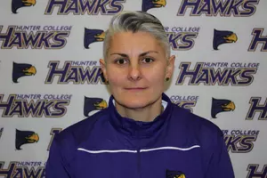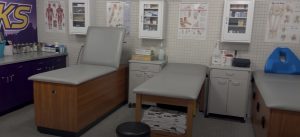Amy O’Connor stands at her desk in the Hunter College West building. Two floors below the subway level, there are no windows. She is tired from the day before but ready for what comes today. Yesterday, O’Connor took the bus to Randall’s Island to cover the men’s soccer practice at 8 a.m. Today, she prepares for her eight-hour practice, where Hunter’s other 17 teams and approximately 250 student-athletes practice.
O’Connor had to do much of this work by herself during the 2023-2024 season. Last June, she learned that the other trainer, Philena Latcha, would be leaving Hunter to work at John Jay College. For the next seven months, Amy O’Connor had to deal with 18 different sports teams as the only athletic trainer on staff.
“I came to Hunter with an expectation that there were going to be two of us,” O’Connor says. There wasn’t much time to sulk. She had to prepare for fall athletics, which was approaching quickly. After hearing the news, O’Connor said the athletics department was asking itself, ‘There is one trainer now. What will we do, and how will we cover all of this stuff?’ It was a hard enough schedule to create for two athletic trainers. One seemed nearly impossible.
O’Connor had worked by herself before, for six years at York College, another school in the CUNY Athletic Conference. At York, she worked with 17 teams in the athletics department as the athletic trainer. She says having that experience prepared her for what she eventually encountered at Hunter College.

The athletic trainer must be present at Hunter College for all home practices and games. There are also many back-end parts of her job. She is the SAAC (Student-Athlete Advisory Committee) faculty rep; she takes care of the vans the athletic teams use to commute to away games. On top of the 8:00 a.m. trips to Randall’s Island and eight-hour working shifts, O’Connor says, “There’s no socializing after that because you are exhausted. You get home, shower, eat dinner, and go to bed to get ready for the next morning.”
O’Connor says she experienced a lot of “frustration and burnout” during her year as Hunter’s only athletic trainer. Finding a new athletic trainer in the CUNY system is complicated. Not only does Hunter have to approve the hiring process, but CUNY Central also has to approve it. CUNY Central is where new faculty are approved and hired to work in the City University system. The athletics department also has to take the time to post the job listing, recruit applicants, interview them, and find someone who is the right fit.
Amy O’Connor moved to the United States from London in 2009 to study athletic training at Montclair State University in New Jersey. She’s an avid soccer player and coach. When she has free time, she says she spends a lot of it either playing or coaching soccer.
This year, Hunter College has two athletic trainers again. Over the summer, Hunter Athletics hired Ashley Morrison, doubling the available athletic trainer hours. Morrison was the head athletic trainer at Saint Joseph’s University in Brooklyn. She graduated with a master’s in sports science from Long Island University in 2020. Morrison says the athletic training community is small, so she has known Amy for a long time. Morrison knew O’Connor as “The English trainer in CUNY” because of her strong British accent. Morrison also says, “Amy is part of the cohort of trainers I would trust with my athletes and feel safe that adequate treatment is given.”
Morrison also stresses the importance of having two athletic trainers and says, “Being able to have multiple trainers on staff to provide adequate support and safety to athletes should be the priority of any organization.”

“Consistency,” O’Connor says. “The athlete needs consistency, and two full-time athletic trainers bring that.”
During the year she spent as Hunter’s only staff athletic trainer, at times, the athletics department could bring in a per diem, which is essentially a substitute teacher. Many of the per diem have outside jobs and don’t have the same access as full-time trainers.
The athletic training room is a vital part of athletics, and O’Connor works closely with student-athletes every day. When they get hurt at practice, they are sent to her. If an athlete gets injured during a game, O’Connor is on the sideline, ready to assess and handle the situation. Solomon Kumi, 20, plays on the men’s outdoor track and field team and hurt his hamstring in practice last year. Kumi was then sidelined for two months. O’Connor worked with him, rehabilitating his hamstring so that he could return to competing. “Amy pushes each athlete to be the best they can be,” says Kumi. “She always, always makes sure that we are healthy enough to perform at our best.”
When asked about her favorite part of her job, she smiles and says, “The student-athletes make coming to this job easy. As the athletic trainer, we are here for the athletes, and seeing them grow and achieve things is about all you can ask for as an athletic trainer.”
With two athletic trainers on staff, it makes it easier now for O’Connor to take vacation days and visit her family back home in England. O’Connor says she’s also able to clock out at a reasonable hour now, giving her more time to compete in her club’s soccer games or just sit on the couch with her tea.









